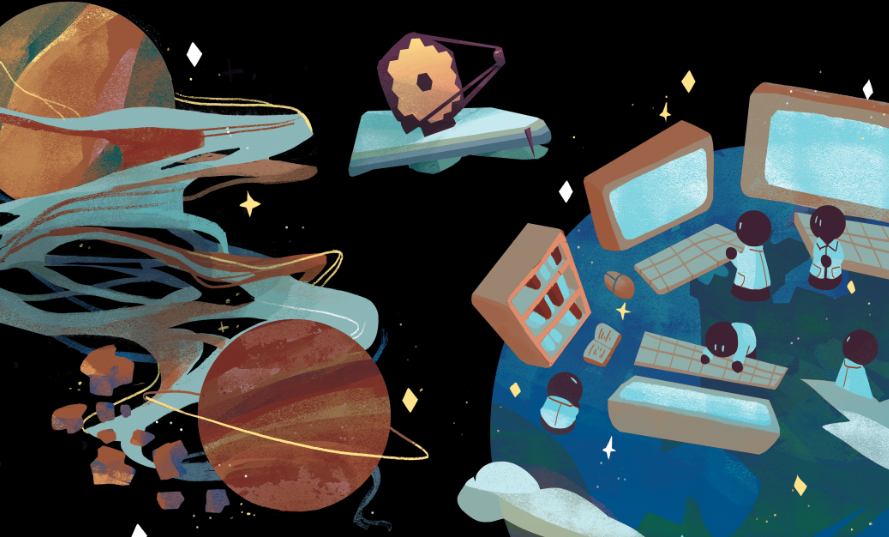In about a year from now, thousands of miles out in space, the James Webb Space Telescope (JWST) will unfurl its mirrors and begin delivering data about the very birth of the universe. In our corner of the planet, RIT professors and students will be interpreting that information to resolve long-held questions about how it all began.
Astrophysics Professor Jeyhan Kartaltepe is part of CEERS (Cosmic Evolution Early Release Science Survey), a group of scientists who will be some of the first to receive and analyze JWST data. Director Don Figer and his team at the Center for Detectors (CfD), on the other hand, are working on developing infrared detector technology that will support the next generation of telescopes.
Unlocking the Galaxies of the Past
In the first week of February, Kartaltepe met with her fellow CEERS scientists in Houston to plan for the influx of data that is expected post-launch.
“We need to start considering what sort of simulations we can run,” Kartaltepe said, while en route to her next conference in Hawaii. “We’ve been generating a lot of simulated data so we can test all of our tools, that way we’re ready to go when the real data gets here.”
The JWST has been decades in the making, so it's understandable why Kartaltepe and her peers are eager to begin analysis. Developed jointly by NASA, the European Space Agency and the Canadian Space Agency, the JWST was first proposed in 1996 as an instrument to see the first generation of stars.
“There’s still a lot of discussion on how galaxies first form,” said fifth year Astrophysics PhD candidate Kevin Cooke. “Do they form as one massive piece with lots of stars together? Is the early universe lots of small collections of stars that piece themselves together into the shapes we see today? There’s so many questions about galaxies that James Webb will help address.”
"It will almost certainly find new things and new questions that we didn't even think to ask."
Kartaltepe agreed — the JWST will certainly have a tremendous impact on our knowledge of the early universe, perhaps even in some yet unforeseen ways.
“There are some things that the JWST was designed to do and look for — but it will almost certainly find new things and new questions that we didn’t even think to ask,” she said.
Kartaltepe is also excited for what this opportunity could mean for RIT students.
“It’s worth pointing out that our students will have access to this data. So far, there hasn’t been a lot of involvement in the proposal process since that’s a bit higher level. But once we get the data here, it will be great to have students working on it,” Kartaltepe said.
Cooke pointed out that receiving this data so early on in JWST’s tenure is also advantageous for the university.
“With [Kartalepe] being part of this survey, RIT’s research group is going to have access to data from the James Webb telescope much faster than other universities,” Cooke said. “So we’ll really be pioneering on how to use it.”
The Future of Space Telescopes
Don Figer, director of the Center for Detectors, is another RIT faculty member who is very familiar with the JWST. Before coming to the university, Figer actually worked at the Space Telescope Science Institute.
“At that time, we were selected as the sole laboratory to comparatively characterize the competing detectors for JWST,” Figer said. “And based in part on our experiments, NASA ultimately chose what type of detector to put on the JWST.”
With the detectors on the JWST decided, Figer and his team have turned some of their attention to investigating the next generation of detectors. Recently, the CfD received a grant to develop silicon-based detectors with industry giant Raytheon.
While most detectors are supported by wafers made out of sapphire or cadmium-zinc-telluride, the idea of silicon-based detectors is a tantalizing possibility.
“To make a detector, you have to deposit the detector material on something that will hold it, and that’s typically referred to as a wafer,” Figer explained. “Commonly available wafers are made of silicon, because that’s what the computer industry uses.”
Because silicon wafers dominate the tech industry, there is already a ton of infrastructure in place to produce them cheaply and efficiently. Given these factors, it would seem like silicon wafers would be the natural choice for supporting high-powered detectors.
The only problem: the atomic crystal of the detector material and silicon wafers’ don’t line up, resulting in faulty detectors. However, if Figer and his team are able to crack the code, it could mean a huge leap forward for detector technology.
“Silicon wafers cost zero dollars, essentially — especially when compared to the cost of a detector,” Figer said. “They could also be made to very large sizes too, the size of silicon wafer — and silicon wafers can be huge.”
Already, Raytheon has developed some silicon wafer detectors that look very promising. Now, with a joint grant of 4.5 million dollars from NASA and the National Science Foundation, the hope is to have silicon wafer detectors on the next space telescope.
Though he may be looking to future telescopes now, Figer is still very eager see what the JWST will discover in the years to come.
“I think it has something to offer for just about every astronomer. Not every astronomer is looking at the early universe,” Figer said. “There are people who are trying to find other planets, another earth ... Then there are people who study massive stars, which you can see further away with the James Webb Telescope. There’s a lot of possibilities.”








